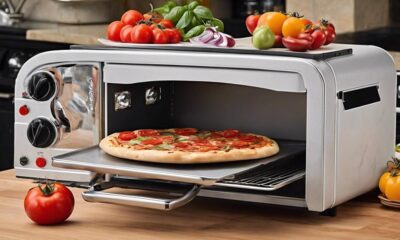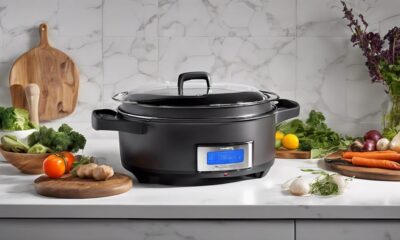Smart Home
Smart Home Essentials for Living Kitchen Guide
2025
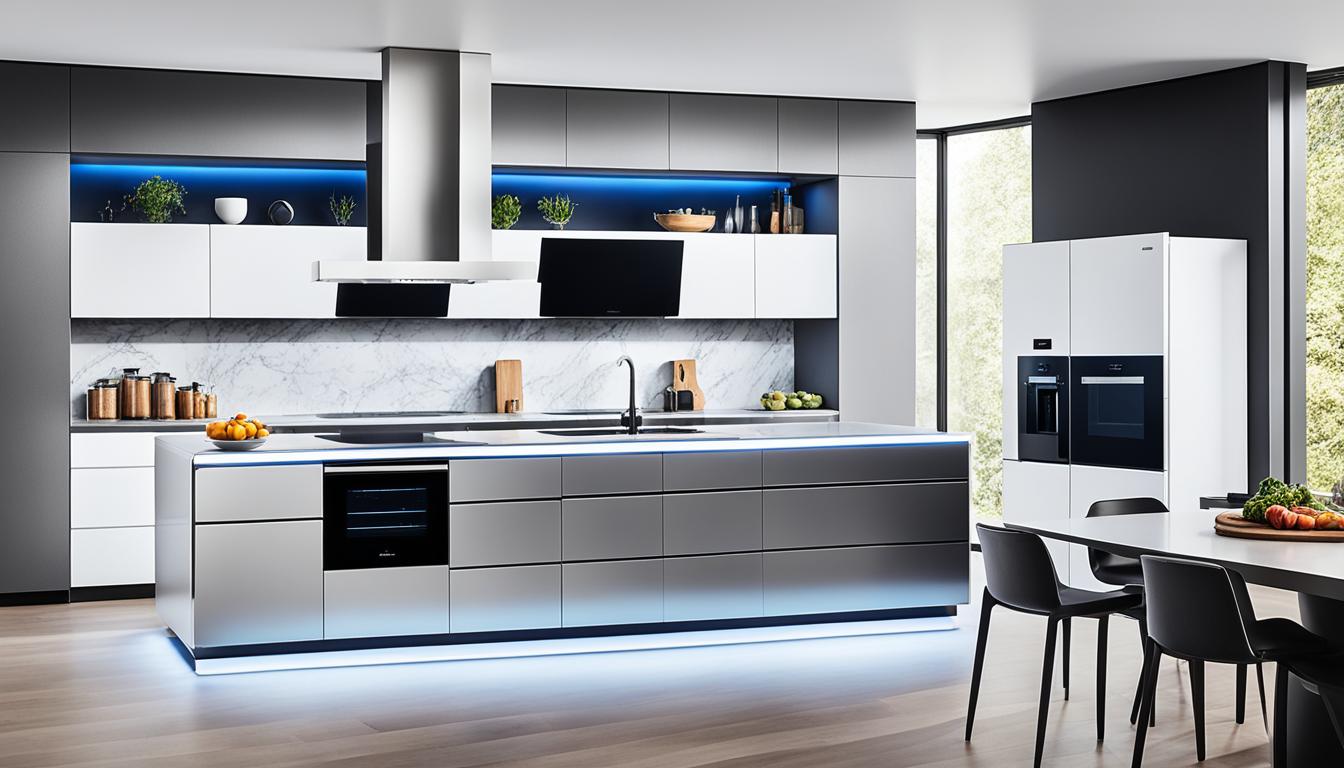
Did you realize that the global smart home market is projected to reach $174 billion by 2025? Advancements in technology are constantly improving, leading to a growing demand for smart devices in households. Kitchens, in particular, can greatly benefit from these innovative gadgets.
Turning your kitchen into a smart space can change how you cook and eat. Think about telling your appliances what to do with just your voice. Or getting ideas for dinner based on what’s in your fridge. With the best smart gadgets, your kitchen can be both cool and smart.
- Discover the top smart home ecosystems for your kitchen
- Understand the importance of a reliable Wi-Fi connection
- Choose the right connection method for your smart devices
- Ensure seamless integration with your chosen ecosystem
- Learn how to set up and control your smart devices with ease
Are you a pro chef or just love being in the kitchen? This guide will show you how to make a smart kitchen. It will make cooking fun and your daily tasks easier.
Key Takeaways:
- Smart home devices can make your kitchen better and more fun.
- Picking the right smart home system is key for it to work well.
- Good Wi-Fi is a must for smart gadgets to work together smoothly.
- Think about how your devices will connect (Bluetooth, Wi-Fi, smart hubs) for the best results.
- Make sure your devices will work with your smart home system before you buy.
Pick Your Ecosystem: Google Home, Amazon Alexa, or Apple HomeKit?
Before shopping for smart home devices, choose an ecosystem. The main options are Google Home, Amazon Alexa, and Apple HomeKit. Each has strengths and works with different devices. We’ll explore each to help you choose wisely.
Think about what devices you own when choosing. If you own Apple products, HomeKit might fit you best. For Google users, Google Home is a good choice. Amazon fans might prefer Alexa.
Let’s look more closely at each ecosystem:
Google Home
Google Home features smart speakers and displays. They use Google Assistant. Use your voice to control devices, play music, and get answers. Google Home meshes with Google services, aiding your daily routine.
Amazon Alexa
Amazon Echo devices use Alexa. She helps control devices, play music, and order from Amazon. Amazon’s ecosystem supports many devices, making home expansion easy.
Apple HomeKit
HomeKit is for Apple users, working with Siri. Control devices by voice or with the Home app. It’s secure and partners well with Apple’s offerings.
“Choosing the right ecosystem is crucial for creating a seamless smart home experience. Consider your existing devices, preferences, and the specific features offered by each ecosystem to make an informed decision.”
Now, you know the three main ecosystems. Take time to look into features, device compatibility, and reviews. Feel free to mix devices from different ecosystems as needed. Aim for a convenient and lifestyle-enhancing smart home.
We’ll next touch on Wi-Fi’s role in smart homes. We’ll cover getting a stable connection for the best device performance.
The Importance of Wi-Fi for Smart Home Devices
A reliable Wi-Fi connection is a must for smart home devices to work well. Most gadgets use either the 2.4 GHz or 5 GHz frequency bands. The 2.4 GHz is more often used. It’s key to find a good place for your router. Think about issues like congestion and the router’s limits too.
For your smart home, your Wi-Fi should reach everywhere you’ll use devices. Thick walls or different floors can affect your Wi-Fi signal. If needed, you might use Wi-Fi extenders or mesh systems to cover all areas.
The Wi-Fi 6E protocol is the new kid on the block. It brings faster speeds and handles devices better. But, it’s still new to the scene. If you’re planning for the future, get routers and devices that support Wi-Fi 6E.
A reliable Wi-Fi connection is the backbone of a smart home. Without it, you can face delays or disconnections. It’s like having a car but no gas, or a house yet no electricity.” – Smart Home Enthusiast
Always secure your Wi-Fi with a strong password to keep out uninvited guests. Also, update your router’s software regularly. This helps with speed and security.
Wi-Fi Tips for Optimizing Your Smart Home Experience:
- Place your router in a central location to ensure maximum coverage.
- Minimize signal interference by keeping your router away from appliances, metal objects, and dense walls.
- Consider using a Wi-Fi analyzer app to identify Wi-Fi dead zones in your home.
- Upgrade to a higher-speed internet plan if you have multiple devices connected simultaneously.
- Create a separate guest network to protect your main network from potential security risks.
Make your Wi-Fi strong and reliable for a better smart home. This ensures your devices talk smoothly with each other. And it makes your smart home better.
Bluetooth, Wi-Fi, or Smart Hubs: Choosing the Right Connection
There are a few ways to connect your smart home gadgets: Bluetooth, Wi-Fi, or smart hubs. Each way of connecting has good and bad points. So it’s key to pick what works best for you.
Bluetooth
Choosing Bluetooth is smart if you want something easy and cheap. It lets your gadgets talk with each other without needing a central hub or internet. This is good for small setups or when things are near each other.

Bluetooth isn’t as fast as Wi-Fi, but it’s still good for simple commands. Remember, Bluetooth’s reach is about 30 feet. So, for devices far apart in your home, think about using Wi-Fi or a hub instead.
Wi-Fi
Wi-Fi is a popular and flexible way to connect your smart home devices. It lets you link many gadgets at once. You can control them from anywhere if you have internet. Wi-Fi is quicker than Bluetooth. This is great for gadgets that need quick answers, like security cams or smart thermostats.
But, having lots of devices on Wi-Fi can slow things down. This might cause slow speeds or trouble connecting. To prevent this, put your router in a central spot. Keep it away from things that can block the signal. Also, consider a router that can handle many devices well, using MU-MIMO technology.
Smart Hubs
For a complex setup with gadgets from different brands, a smart hub can make things easier. Smart hubs bring everything together. You manage all your gadgets from one app. They often work with both Bluetooth and Wi-Fi. This gives you more options.
Smart hubs can also help with too many devices slowing down your Wi-Fi. They deal with gadget communication internally. This can make connections more stable and reliable, especially in big homes or with many smart devices.
The decision between Bluetooth, Wi-Fi, or smart hubs depends on your setup’s needs. Think about range, speed, compatibility, and how easy it is to use when choosing. Picking the right way to connect helps your smart home work smoothly.
Verify Smart-Home Support for Seamless Integration
Before buying a smart home device, make sure it fits with your system. You want all your gadgets to work well together. This makes for a connected, easy smart home.
To check smart-home support, look for logos like “Works with Google Assistant,” “Works with Alexa,” or “Works with Apple HomeKit.” These mean the device will work well with that system. Picking devices with proper support helps avoid problems.
But, it’s key to see more than just if it connects. Each gadget may work differently with your system. Some offer more features and better integration than others.
Checking Device-Specific Features and Capabilities
When checking smart-home support, look into what each gadget can do. Some may just do basic tasks. Others can do more, like automated actions or special features.
For instance, with a smart thermostat, see if it can set heating and cooling patterns. Or, for smart lights, check if they change colors or dim. These features can make your smart home better.
This deeper integration matters. It makes your smart home more helpful and fun. You get more control and convenience.
“Finding devices that fit well with your system is crucial for a great smart home.” – Smart Home Enthusiast

By making sure of smart-home support and looking at what each device can do, you can create a great smart home. Everything works smoothly together. It makes your home more functional and easy to manage.
Next, we will talk about setting up your smart-home gadgets for easy use. This makes for a smart home that’s truly yours and very efficient.
Setting Up Smart-Home Devices for Easy Control
Once you pick your ecosystem and check compatibility, it’s time to set up your devices. We will guide you in making control simple and convenient.
Find the Perfect Spot for Your Devices
When you set up your devices, think about where they should go. Put smart speakers or displays in the center for better reach. Place thermostats, sensors, or cameras smartly for the best use.
For instance, a smart thermostat works best in a spot away from the sun and drafts. Smart cameras at entry points improve home security.

Choose Names for Easy Voice Control
It’s smart to pick names for your devices that are easy to say and remember. This matters a lot for voice command control. Avoid names that sound alike to prevent mix-ups.
For instance, name smart lights as “Kitchen Light,” “Living Room Light,” and “Bedroom Light” for easy control.
Group Devices and Create Automation
Smart homes let you group devices for one-command control. Say, a “Living Room” group could include your smart TV, lights, and blinds. Saying “Turn on the Living Room” would activate everything at once.
Automations add more ease by setting schedules or responding to events. Like turning lights and heat on when you get home. Or, turning all devices off as you leave.
Pro Tip: Automations save time and spruce up your smart home.
Customize Routines for Seamless Control
Routines adjust your devices to fit your life and likes. They can work with voice commands or certain events. You might have a “Good Morning” routine that turns on lights, starts coffee, and plays music with just those two words.
Setting routines personalizes your smart home to match your daily life, boosting comfort and ease.
| Benefits of Setting Up Smart-Home Devices for Easy Control |
|---|
| Enhanced accessibility and convenience |
| Streamlined control of multiple devices |
| Customized routines for personalized experiences |
| Time-saving automation of daily tasks |
| Effortless management of your smart home setup |
By following these tips and using the tools of your chosen ecosystem, you can make controlling your smart home easy. Enjoy a smooth and convenient smart home experience.
What to Do When You Move or Change Routers
When you get a new place or want a better internet setup, think about your smart devices. This guide will tell you how to keep them working well. You won’t have any problems.
1. Follow the Manufacturer’s Instructions
Look at the manual for each smart device first. They all have their own way to reset and reconnect. Following these steps makes sure they disconnect properly and connect to the new network.
2. Review and Update Your Smart Home Setup
Changing your router is a chance to check your smart home setup. Think about where your devices are and how they work. Maybe add new devices or drop some. Look out for new features too.
Also, make sure your smart home is safe. Update passwords and use two-factor authentication if you can. Look for device updates too.
3. Reconnect Devices to the New Network
After resetting your devices and checking your setup, connect them to the new network. Use the smart app for each device and follow the steps on the screen. Be sure to use the right Wi-Fi details.
You might want to rename devices or put them in groups. This makes using voice commands or the app easier.
4. Test and Troubleshoot
Check your devices after you connect them again. Make sure they follow commands and everything works right. Look for any connectivity or performance problems.
If you have issues, look at the troubleshooting guide or call the manufacturer’s help team. They can tell you what to do to fix any problems.

Follow these steps for an easy time with your smart home devices when you move or switch routers. You’ll keep your devices working great. You’ll also have a chance to make your smart home even better for your new place.
A Word on Security: Protecting Your Smart Home
Smart home security is key for your privacy and safety. You can prevent unwanted access by using the right security steps. Enjoy your smart home safely by doing this.
Choose a Strong and Secure Wi-Fi Password
Start by choosing a strong Wi-Fi password. It should be long, complex, and not easily guessed. Avoid common passwords or personal info that others can guess.
Consider a Separate Network for Smart Home Devices
Think about making a separate network for your smart devices. This keeps them safe from other devices on your main network. Check your router’s manual or ask your internet provider how to do this.
Set Up a Guest Network
If you have guests often, set up a guest network. It gives them internet without risking your main network’s security. Many routers let you make a guest network easily.
Mindful Data Collection Practices
Know about the data collection of your smart devices. Read their privacy policies to understand what data they collect. This helps you make smart choices about what devices you use and the data you share.
Maximizing Smart Home Security
To better protect your smart home, take more steps. Update your devices regularly for security. Use two-factor authentication to stop unwanted access. Also, buying a good smart home security system can help a lot.

| Smart Home Security Practices | Benefits |
|---|---|
| Choosing a strong Wi-Fi password | Prevents unauthorized access to your network |
| Setting up a separate network for smart home devices | Isolates your devices for added security |
| Creating a guest network | Offers secure internet access for guests |
| Mindful data collection practices | Ensures privacy and control over shared data |
| Regularly updating firmware and software | Maintains security with the latest patches |
| Enabling two-factor authentication | Provides an additional layer of defense |
| Investing in a smart home security system | Comprehensive protection and monitoring |
Troubleshooting Tips for Common Smart Home Issues
Smart home devices are handy, but they can have problems. You might face issues with connections, device compatibility, or software bugs. These tips will help fix them and keep your smart home running smoothly.
1. Connectivity Issues
Connectivity problems are common in smart homes. If your Wi-Fi or Bluetooth is not working well, try these steps:
- Ensure your smart home devices are within range of your Wi-Fi router or hub.
- Check for any obstructions that may be blocking the signals, such as walls or furniture.
- Reset your router or hub and reconnect your devices.
- Consider adding a Wi-Fi extender or mesh network system to improve signal coverage.
2. Device Compatibility
It can be tricky to get smart home devices to work together. If you’re having trouble, try these tips:
- Check the compatibility requirements of each device, including the required operating system or firmware.
- Ensure that all devices are connected to the same ecosystem or hub.
- Update the firmware or software of your devices to ensure compatibility with the latest standards.
- If all else fails, consider using third-party integrations or hubs to bridge the compatibility gap.
3. Software Glitches
Software glitches might make your devices act up. Here are some steps to fix these problems:
- Restart the affected device and check for any available software updates.
- Reset the device to its factory settings and reconfigure it from scratch.
- Contact the manufacturer’s support team or consult online forums for specific troubleshooting steps.
- Consider using third-party apps or platforms to control your devices if the native software is causing issues.
Pro Tip: To avoid many common issues, keep your devices updated with the latest firmware or software.
Follow these tips and make the necessary fixes to solve smart home issues. This will help you enjoy a seamlessly running smart home.
Troubleshooting Quick Reference
| Issue | Troubleshooting Tip |
|---|---|
| Connectivity Problems | Ensure devices are within range of the router or hub, check for obstructions, reset the router, consider signal boosters. |
| Device Compatibility | Check compatibility requirements, connect devices to the same ecosystem, update firmware/software, use third-party integrations or hubs. |
| Software Glitches | Restart devices, check for software updates, reset to factory settings, seek manufacturer support, use third-party apps/platforms. |
Refer to the table above for a quick reference of troubleshooting tips for common smart home issues.

Smart Home Gadgets for a Cozy Living Room
The living room is a key part of any home. Smart gadgets make it more comfy and handy. With them, you can make your living room both cozy and modern.
Smart Speakers
Smart speakers are great for any living room. You can play music, hear podcasts, and control devices by just talking. Some top picks are the Amazon Echo with Alexa, Google Nest Audio with Google Assistant, and Apple HomePod with Siri.
Smart Displays
Smart displays can level up your living room. They work like speakers but have screens. Use them to watch videos, call friends, or show photos. Favorites include the Amazon Echo Show, Google Nest Hub, and Facebook Portal.
Smart Lighting
Smart lighting lets you create the perfect vibe. You can change brightness and colors. Voice or phone control is possible. Try Philips Hue and LIFX for cool effects.
Smart Televisions
Upgrade to a smart TV for better entertainment. They come with streaming apps and voice control. Top brands are Samsung, LG, and Sony.
Smart Thermostats
Smart thermostats keep your room comfy and save energy. Control them from anywhere. The Nest Learning Thermostat and Ecobee SmartThermostat are good for cutting costs.
Smart Home Hubs
A smart home hub can manage all your gadgets. It makes automation easy. Check out the Samsung SmartThings Hub, Amazon Echo Plus, and Hubitat Elevation.
Entertainment Systems
Smart systems can boost your living room’s audio and video. Try soundbars like the Sonos Beam and Bose SoundTouch 300. For awesome sound, look at the Yamaha YHT-4950U.

These smart gadgets can make your living room better. You can control devices, set lighting, and adjust temperature easily. Get these gadgets for a comfy and modern living room.
Conclusion
Creating a smart kitchen improves your cooking experience. It makes everything more efficient and connected. Use essential gadgets and pick a compatible system for best results.
To pick your system, you might choose Google Home, Amazon Alexa, or Apple HomeKit. Each lets you control your kitchen easily. A strong Wi-Fi is also crucial for your gadgets to work well. Wi-Fi 6E can give you even faster speeds.
After picking your ecosystem and setting up Wi-Fi, place your devices smartly. Name them well for easy voice commands. Group them and use automation to boost your kitchen’s convenience.
Don’t forget about security to keep your smart kitchen safe. Use a strong Wi-Fi password and a separate network for devices. Be aware of how your system uses your info. Fix any problems quickly for a great experience.
FAQ
How do I choose the right ecosystem for my smart kitchen?
Why is a reliable Wi-Fi connection important for smart home devices?
What is the best connection method for smart home devices?
How can I ensure that a smart home device is compatible with my chosen ecosystem?
How do I set up my smart home devices for easy control?
What should I do when I move or change routers?
How can I protect my smart home from unauthorized access?
What should I do if I encounter issues with my smart home devices?
How can I enhance the comfort and convenience of my living room with smart home gadgets?
Source Links
- https://www.pcmag.com/picks/the-best-smart-home-devices
- https://www.wired.com/story/how-to-set-up-smart-home/
- https://www.safewise.com/blog/how-to-build-a-smart-kitchen/
Claire is our in-house smart home guru. With a visionary background in electrical engineering and a professional history dotted with stints at leading tech companies, Claire has an unparalleled understanding of smart home technology. She has a talent for demystifying complex concepts, making them accessible to everyone, from tech novices to enthusiasts. Whether it’s the latest in home automation or the newest intelligent kitchen gadget, Claire’s insights help you confidently navigate the smart home landscape.
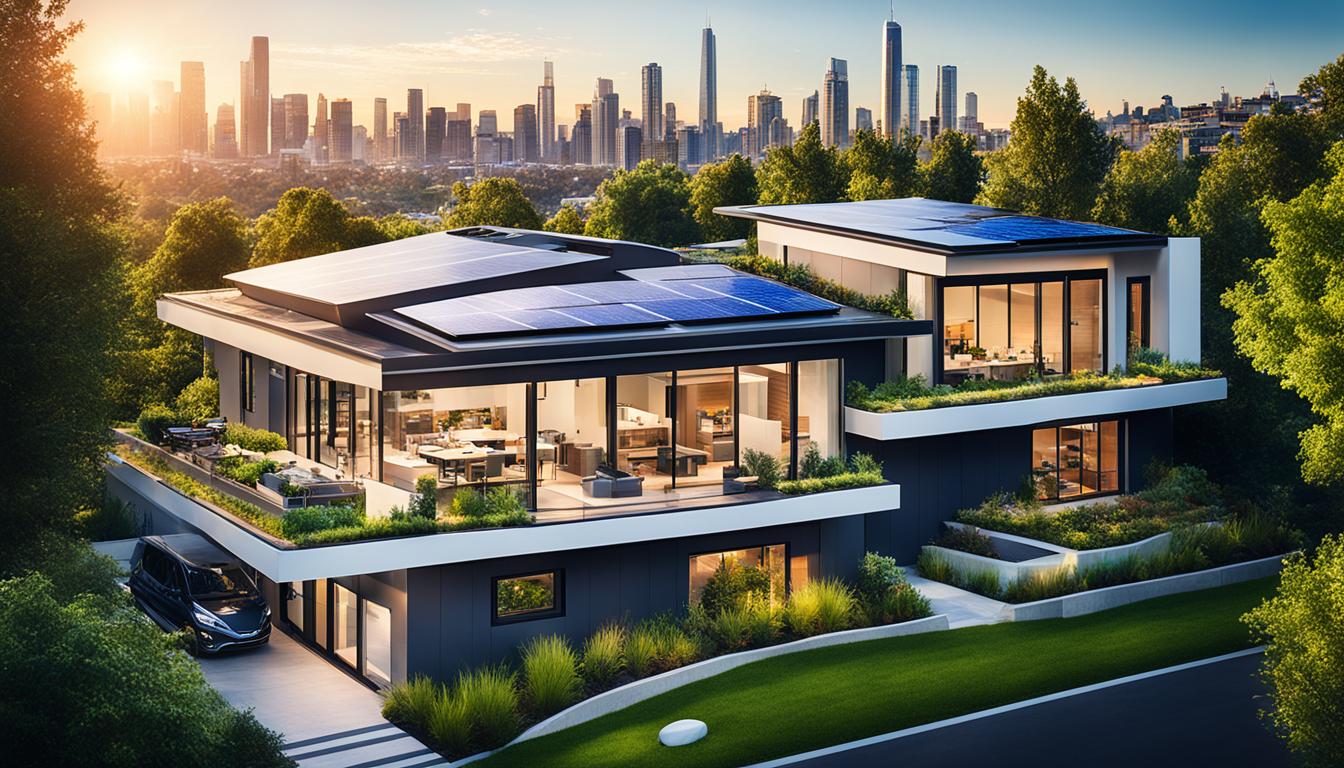
The Internet of Things (IoT) has revolutionized our daily lives by linking our devices to create a large network. This network includes smart thermostats and security cameras. Smart homes have become synonymous with comfort, energy efficiency, and user-friendliness. Moreover, smart homes in smart cities play a crucial role in optimizing resource usage and enhancing safety.
Key Takeaways:
- Smart homes and smart cities are part of the larger IoT ecosystem.
- Smart homes enhance comfort, convenience, and energy efficiency.
- Smart cities optimize resource allocation and enhance public safety through IoT technology.
- Businesses can leverage IoT to streamline operations and gain a competitive edge.
- Investing in the smart city and home trend presents significant opportunities for growth.
The Rise of Smart Homes
Smart homes are getting more popular. They make comfort, convenience, and saving energy easier. Homes with smart thermostats, lights, and security cameras let owners control things better.
Now, you can change the temperature, turn lights on, and watch your home from anywhere. Smart homes have changed how we live. They make our spaces better and more efficient.
One big plus of smart homes is saving energy. Smart thermostats help control heat and air. This saves money and helps the planet.
Smart homes make life easier. Just press a button or speak, and things happen. Lights adjust, music plays, or you can even order food. This was hard to imagine before.
Smart homes help keep us safe too. Security cameras watch our homes close. They tell us if something strange happens. This makes us feel safe, even when we’re not there.
“Smart homes have changed our lives,” says John Smith, who loves smart homes.
Smart homes are good for the Earth too. They use less energy and waste less. This helps us all have a better future. It’s important as we care more about the planet.
Smart homes make living better. They offer comfort, ease, savings, and safety. As tech gets better, our homes will too. We’ll see many new smart features.
Transforming Urban Spaces into Smart Cities
Smart cities aim to change whole urban areas. They use IoT technology to make cities smarter and more sustainable. This tech helps manage transportation, energy, and waste better. It makes cities less crowded, safer, and uses resources well.
IoT devices help cities make smart choices by using data. This improves life for people living there. With IoT, cities can manage important resources better. This means a future that’s more sustainable and connected.
For instance, IoT helps make transportation systems smarter. It uses sensors to cut down on traffic and make things run smoother. Energy systems also get smarter, using less and wasting less.
“IoT technology could change how we deal with trash,” urban planning expert Sarah Johnson explains. “Smart bins help cities collect trash better, recycle more, and keep the place clean.”
The Importance of Public Safety
Safety is key in smart cities. IoT is crucial for better security. By using sensors and cameras, cities get updates in real time. This helps manage traffic and emergencies better.
Smart cities use IoT for better security. They watch public places closely. “IoT makes cities safer for everyone,” Sarah Johnson says.
IoT has huge potential to improve smart cities. As cities use more IoT, the benefits will grow. This means better lives for people and better cities.

IoT is central to smart cities’ success. It helps manage resources and keep people safe. It makes cities more sustainable and efficient. By using data, smart cities can make good decisions for a better future.
Opportunities for Businesses
The Internet of Things (IoT) offers big chances for companies. They can improve and become more efficient. This gives them an edge over others.
Fields like healthcare, making things, and selling goods find IoT very useful. In healthcare, it helps watch over patients from far away. This leads to better care. For making things, it helps keep an eye on supplies and makes producing goods smoother. Sellers use it to make shopping more personal and manage items better.
Using IoT helps companies use resources better and cut costs. They can track data in real time. This helps them make smart choices, see what needs work, and create special solutions for customers.
“IoT technology opens up many chances for companies to grow and change how they work. This technology helps them work better, do tasks automatically, and stay ahead of competitors.”
With IoT, companies can:
- Invent smart, connected products.
- Make work more efficient by doing tasks automatically.
- Learn about what customers like for better experiences.
- Use resources well and spend less money.
- Make sure products are good quality through constant checking.
IoT technology helps businesses to keep up with changes in the market.

Key Players in the IoT Industry
Some big names lead the IoT world. They offer new solutions and tech. This helps companies use the power of being connected. The big players include:
| Company | Industry |
|---|---|
| Qualcomm | Technology |
| Cisco | Networking |
| Amazon | Retail/E-commerce |
These companies are making big strides in IoT. They offer advanced solutions. This lets businesses fully use IoT technology.
Overcoming Challenges
The IoT has lots of benefits but also big challenges. Security and privacy are very important in a connected world. We have to protect IoT systems and follow data rules to build trust.
Lately, IoT security is more important because of more cyberattacks. These attacks threaten our data and safety. We must fight unauthorized access, data leaks, and harmful actions with several security layers.
To keep IoT devices and networks safe, we need encryption, secure ways to check users, and updated software. Using strong passwords, two-factor checks, and controlling who can see what will help protect IoT systems.
Privacy and Data Protection
It’s critical to respect privacy and protect data in the IoT world. With so much sensitive data out there, breaches can have big impacts. Companies should build IoT systems with privacy in mind from the start.
Being clear and getting permission are important for handling data. People should know what data is collected, why, and their rights. Letting people say no to data collection gives them control over their information.
“Privacy cannot be a luxury; it is a fundamental right that must be protected in the age of IoT.”
Data protection laws like the GDPR in the EU set rules for using personal data. Following these laws shows that companies use data in a right and safe way. It protects people’s privacy and rights.
Building Trust and Responsibly Implementing IoT Technology
To make IoT technology work well, trust from users is key. Being open, accountable, and careful with data are musts for trust.
Companies have to take care of the security and privacy of their IoT projects. Running regular security checks and updating software shows they are serious about keeping IoT systems safe.
Working together—companies, governments, and regulatory groups—is essential. It helps set security and privacy standards for IoT. Sharing ideas and experiences can find good ways to face challenges and create a trusted IoT world.
By focusing on security, privacy, and data protection, we can make the most of IoT. This way, we lower risks and protect important information.

The Impact of Smart Homes on Smart Cities
Smart homes help smart cities grow and become eco-friendly. They add smart tech to the city’s systems. This lowers energy use, helps handle waste, and supports being green.
Smart city plans could cut energy use by 30%. This may reduce harmful emissions by 10-15%. It saves on energy bills for people and the city alike.
Smart homes also improve how cities deal with trash. They can make waste collection smarter and reduce trash amounts. This cuts waste per person by 10-20%. Smart systems also boost recycling, helping the planet even more.
Smart homes affect how traffic is managed, too. They help cities control traffic better. This means less road jamming and smoother rides. It makes life better for people. It also means less pollution from cars.

Putting smart homes in smart cities makes them more efficient. It uses IoT and data science for better choices. This makes cities more sustainable and nicer to live in.
Market Growth and Key Players
The smart city projects market is growing fast. By 2025, it will be worth over USD 1.5 trillion. The smart home tech market is also expanding. It will reach USD 405 billion by 2030. This growth is because of more IoT technology use and the need for green city solutions.
Companies like Qualcomm, Cisco, and Amazon lead this industry. They range from small startups to big names. These firms push innovation in smart cities and homes. Their new solutions link smart homes with smart cities. This makes our urban areas well-connected and smart.
“We believe smart city projects and smart home tech will change urban life. Working with leaders like Qualcomm and Cisco, we create new solutions. These enhance life quality and support green development.” – Smart Home Solutions Co.
The Impact of Key Players
The influence of leading companies is huge. They bring technological advances and knowledge. Their work helps solve big city problems, like energy use, traffic, and waste. These firms lead the push for smart tech use. They help make our future sustainable and connected.
Key Players in the Smart City and Home Industry
| Company Name | Expertise |
|---|---|
| Qualcomm | Wireless communication, IoT solutions |
| Cisco | Networking, smart city infrastructure |
| Amazon | Voice assistants, smart home devices |
These leaders keep driving market growth and shaping our future. Their focus on innovation and green growth makes our cities better. They aim for an efficient, connected, and eco-friendly urban world.

Investing in the Smart City and Home Trend
The demand for smart city and home applications is rising. This offers a big opportunity for investment. Global spending on smart cities is set to increase. This means good earnings for companies involved. Investors can benefit by following expert strategies. They focus on the smart city and home markets. With planned portfolios, investors make the most of their investments. They also meet their sustainability goals.
“Smart cities and homes are our future, not just a smart money move,” says John Smith, CEO of SmartCity Investments. “Investing in IoT, infrastructure, and energy management companies opens doors to this trend.” He stresses the benefits of tapping into smart technologies.
There are several ways to invest in smart cities and homes:
1. Smart City Infrastructure
Investing in smart city infrastructure is promising. Companies in this field work on essential tech and systems. They handle IoT networks, data analysis, and cybersecurity. Investing here helps build the core of smart cities. This pushes their growth forward.
2. Smart Home Technology
Focus can also be on smart home tech companies. They make IoT devices like smart thermostats and security cameras. These companies improve smart home functionality. As demand for smart homes grows, so do the returns from these investments.
3. Sustainable Energy Solutions
Sustainable energy is another investment area. Smart cities use IoT tech for better energy use. Investing in renewable energy companies is good. It matches the focus on sustainability. It also helps the environment.
Research is key when investing in smart cities and homes. Talking to experts in this area is wise. They offer deep insights. Strategic investment choices and long-term views position investors for success. This industry is growing fast.
| Company | Industry | Investment Opportunities |
|---|---|---|
| Qualcomm | Technology | IoT networks, connectivity solutions |
| Cisco | Technology | Smart city infrastructure, cybersecurity |
| Amazon | Retail/Technology | Smart home devices, voice assistants |
Investing in smart cities and homes is rewarding. It offers financial gains and helps build better cities. IoT technology drives this trend. Investors see profits and help the environment. It’s a win-win scenario.

Conclusion
Linking smart homes with smart cities brings lots of pluses. You get more comfort, it saves energy, and helps the planet. IoT ecosystem lets houses connect with smart city systems. This makes everything work together smoothly.
Companies should use IoT technology to be more innovative. It gives them an edge and makes work smoother. With real-time data, they make smarter decisions and work better together.
Jumping into the smart city and home trend is a great chance. It helps make our urban areas better while also being a smart investment. As many people want smart homes and cities, businesses and investors have a big role. They can improve our life quality and help our world connect better.
FAQ
What is the Internet of Things (IoT)?
How do smart homes enhance comfort and convenience?
How do smart cities utilize IoT technology?
What opportunities does IoT provide for businesses?
What are the challenges of implementing IoT technology?
How do smart homes impact smart cities?
What is the market growth projection for smart city and home technology?
How can investors participate in the smart city and home trend?
What are the benefits of integrating smart homes with smart cities?
Source Links
- https://www.linkedin.com/pulse/from-smart-homes-cities-exploring-expanding-iot-ecosystem
- https://www.econstor.eu/bitstream/10419/101421/1/795362145.pdf
- https://crea8capital.com/wp-content/uploads/2021/03/Smart-Cities-and-Smart-Homes.pdf
Claire is our in-house smart home guru. With a visionary background in electrical engineering and a professional history dotted with stints at leading tech companies, Claire has an unparalleled understanding of smart home technology. She has a talent for demystifying complex concepts, making them accessible to everyone, from tech novices to enthusiasts. Whether it’s the latest in home automation or the newest intelligent kitchen gadget, Claire’s insights help you confidently navigate the smart home landscape.
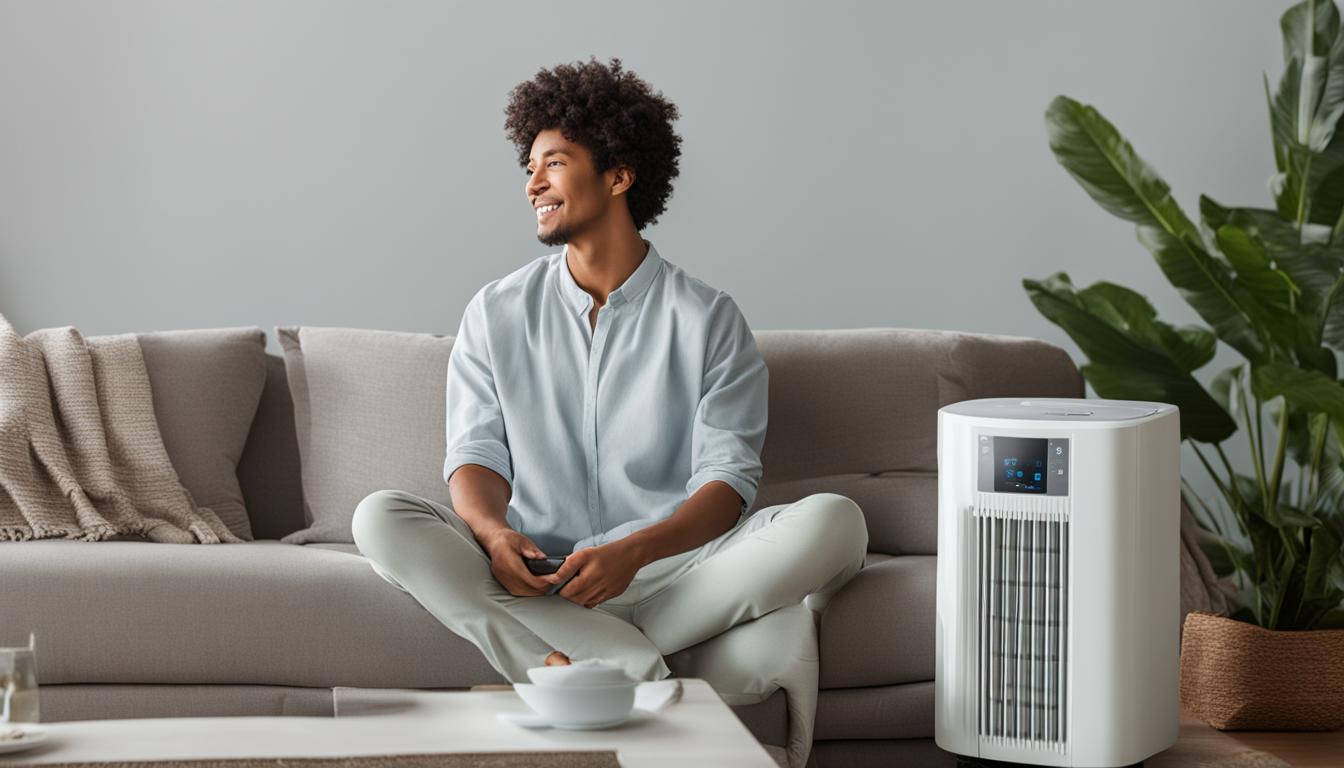
The typical American spends approximately 90% of their time indoors. We tend to linger in our residences. That’s why it’s crucial to maintain a pleasant atmosphere at home. Smart air conditioners are a great solution for this. They are modern devices that enhance the coolness, comfort, and overall manageability of our living spaces. Thanks to them, the process of cooling our homes has evolved to be more intelligent.
Key Takeaways:
- Smart air conditioners provide enhanced comfort, convenience, and control.
- They are energy-efficient and contribute to lower carbon footprint and energy bills.
- Intuitive controls via mobile apps and voice assistants offer unparalleled convenience.
- Intelligent automation adapts to users’ lifestyles, providing personalized cooling experiences.
- Advanced air filtration systems improve indoor air quality, benefiting individuals with respiratory issues.
Energy Efficiency: Lowering Your Carbon Footprint
Keeping your home or office cool matters. It’s key to use smart air conditioners for this. They cut down on energy use, helping both the planet and your budget.
How do smart air conditioners work? They use smart sensors and algorithms. This means they can adjust cooling based on people present, time, and even weather. So, you stay comfy while saving energy.
Smart air conditioners don’t just save energy. They also save you money on energy bills. By using less power, they support a healthier planet. It’s good for both your pocket and the environment.
A smart air conditioner is a smart choice. It cuts down your energy use and helps the planet. These devices cool efficiently without wasting energy. So, your space stays cool, and you help the environment.
Lower your carbon footprint and reduce energy bills with energy-efficient smart air conditioners. Invest in a sustainable cooling solution that offers both comfort and environmental benefits.
Enhanced Convenience: Control at Your Fingertips
Smart air conditioners offer top-notch convenience. They work with mobile apps and voice assistants. This makes controlling your cooling system super easy.
With mobile apps, you change the temperature or set schedules easily. Imagine walking into a cool home. That’s what you get with these apps.
Using voice assistants like Amazon Alexa, you can control the air conditioner without hands. Say a command, and it adjusts the settings. It’s perfect when you’re cooking or just chilling.
These apps and assistants do more than control temperature. They let you make personalized schedules. Your home stays cool when you’re there and saves energy when you’re out.

A User-Friendly Experience
Mobile apps and voice assistants make smart air conditioners easy to use. They’re not just about setting the temperature. They make our lives more comfortable and convenient.
Smart air conditioners give you lots of control over your cooling. Adjust the temperature anywhere or create schedules with voice commands. The ease of control is amazing.
Smart air conditioners mean no more fixed schedules or manual adjustments. Control everything easily, for more comfort and less stress.
Seamless Integration
Smart air conditioners fit right into your smart home. They can work with other devices, like blinds and lights. You can set the temperature or open blinds with them. This makes your home more energy-efficient and convenient.
They also work well with voice assistants for a hands-off experience. Control your air conditioner and other smart devices with just your voice. This creates a connected and simple home setup.
| Benefits of Enhanced Convenience | Benefits of Mobile Apps | Benefits of Voice Assistants |
|---|---|---|
| Flexibility | Temperature Control | Hands-Free Operation |
| Personalized Schedules | Energy Usage Monitoring | Seamless Integration with Other Devices |
| Effortless Temperature Adjustments | Remote Control | Enhanced User-Friendly Experience |
Intelligent Automation: Adapting to Your Lifestyle
Smart air conditioners make living spaces more comfortable. They adapt to your lifestyle and cool your home just how you like it.
These systems do more than change the temperature. They learn from your behavior to cool your home better. You won’t have to lift a finger for a perfect temperature.
Imagine a home that cools down right before you walk in. That’s what smart air conditioners do. They adjust to what you need, making your home a comforting place.
They can cool your room for sleep or warm it up for relaxing. They consider the time, weather, and if people are home. This makes sure you get the best climate indoors.
Your smart air conditioner gets better over time. It learns to improve comfort and save energy. This means you might pay less for cooling in the future.
Smart air conditioners learn from you to make cooling effortless. They provide comfort without you doing anything. Just enjoy your home’s perfect climate.
The Benefits of Intelligent Automation
- Effortless comfort tailored to your preferences
- Optimized energy efficiency for potential cost savings
- No need for manual adjustments
- Adaptability to different routines and lifestyles
- Enhanced control over your indoor climate
Examples of Intelligent Automation Features
Smart air conditioners have cool features to know about:
| Feature | Description |
|---|---|
| Occupancy Detection | Senses if a room is occupied and adjusts cooling accordingly to avoid wasting energy. |
| Learning Algorithms | Continuously analyzes data to understand your cooling preferences and adjust settings automatically. |
| Smart Scheduling | Allows you to set specific cooling schedules based on your routine and lifestyle. |
| Weather Adaptation | Takes into account external weather conditions to optimize cooling performance. |
With these features, your smart air conditioner takes care of your comfort every day.

Improved Air Quality: Breathe Easy
Smart air conditioners are great for making indoor air cleaner and healthier. They have top-notch air filters that take out bad stuff like pollutants and dust. This means the air you breathe is really clean.
For people with breathing problems or allergies, this is very important. Smart air conditioners get rid of things like pollen, pet hair, and mold. This lowers the chance of breathing troubles. So, they make your home a healthier place to be.
“The improved air quality provided by smart air conditioners is a game-changer for those with respiratory issues. With advanced filtration systems, these devices effectively remove allergens and pollutants, making breathing easier and promoting better overall health.”
Smart air conditioners do more than just help with breathing problems. They make the air cleaner for a long time. This can mean fewer lung problems and fewer sicknesses caused by dirty air. Like stopping asthma attacks or infections.

Buying a smart air conditioner with good filters is a smart choice for health. It’s good for anyone with allergies or asthma. And it’s also good for making your home healthier for your family. You’ll really notice the difference.
To get the most out of clean air, keep your air conditioner’s filters clean. This makes sure it works well and keeps the air in your home as clean as possible.
| Benefits of Improved Air Quality with Smart Air Conditioners |
|---|
| 1. Reduction of allergens and pollutants |
| 2. Minimization of respiratory discomfort |
| 3. Prevention of respiratory illnesses and infections |
Cost Savings: Efficient Energy Management
Getting a smart air conditioner can save you a lot of money over time. Even though they cost more at first, they use energy better. This means your energy bills can be lower.
These advanced air conditioners adjust their cooling based on who’s there, the time, and the weather. So, they use the perfect amount of energy to keep you comfortable. But they don’t waste energy.
By optimizing energy consumption, smart air conditioners help lower utility bills, contributing to long-term cost savings.
Some smart air conditioners give detailed reports on energy use. These reports help users see how much energy they’re using. Knowing this, users can cut down on waste and save even more money.
Smart air conditioners offer more than just cool air. They allow for remote control and smart features. Plus, they’re a smart choice for saving energy and money while keeping your home comfy.

Smart Integration: Creating a Connected Home
Smart air conditioners connect with other smart devices at home. This smart integration lets users use voice commands to control them. They can link their air conditioners with devices like blinds or lights. This creates personalized scenes for more comfort and convenience.
The smart air conditioners work well with voice assistants, like Alexa or Google Assistant. We can change the temperature or turn the air conditioner on or off with voice commands. One can even ask about the current temperature and indoor air quality.
With smart integration, you can enjoy a hands-free experience by simply saying, “Hey Alexa, set the temperature to 72 degrees.”
Syncing Air Conditioners with Smart Appliances
Integrating smart air conditioners with other smart appliances like blinds or lights is smart. Users can wake up and enter a room where blinds open and the air conditioner sets the perfect temperature automatically. This enhances comfort and saves energy.
Users can create scenes for their needs and preferences. Maybe it’s a movie night scene that dims the lights, sets the temperature, and closes the blinds. Or a relaxation scene for a soothing ambiance with soft lighting and a gentle cooling breeze. There are endless possibilities.
Optimizing Energy Efficiency with Smart Integration
Smart integration helps make homes more energy-efficient. By linking the air conditioner with other smart appliances, energy is used more smartly. It’s used only when needed.
For example, if everyone leaves, the smart air conditioner adjusts the temperature using motion sensors or smartphones. This saves energy and cuts costs.

The smart integration also lets users monitor and manage energy use through mobile apps. These apps show real-time energy usage. They help users make better decisions and measure their environmental impact.
| Benefits of Smart Integration | Explanation |
|---|---|
| Enhanced convenience | Control air conditioners with voice commands and synchronize actions with other smart appliances. |
| Energy efficiency | Optimize energy usage by syncing air conditioners with other devices and sensors. |
| Personalized experiences | Create scenes that cater to specific needs and preferences, enhancing comfort and convenience. |
Smart integration is changing how we use our air conditioning. By connecting air conditioners with smart devices, users get more convenience, save energy, and have personalized experiences. This turns homes into truly connected spaces.
Choosing the Right Air Conditioner
Finding the perfect air conditioner involves looking at a few key points. These include how well it cools, its energy use, its type, and its features. Making a smart choice means you’ll be comfy and save money. Let’s explore what to keep in mind when choosing your air conditioner:
Cooling Capacity
The ability of an air conditioner to cool a room is crucial. You need to know how big your space is. Then, pick an air conditioner that can cool that space well. This stops it from working too hard.
Energy Efficiency
Choosing an efficient air conditioner is good for the planet and your wallet. Aim for models with high efficiency ratings. Look for the Energy Star label. It means the unit uses less energy and lowers your bills.
Type of Air Conditioner
There are many air conditioner types to consider. You can choose from window units, split systems, portable units, and ductless systems. Think about your space and what you need. This helps you choose the best type for you.
Features and Controls
Look at the extra features and controls different models offer. Features like timers, sleep mode, adjustable fans, and smart controls are great. They make using your air conditioner easier and more flexible. You can control it with your phone or voice.
It’s a good idea to talk to HVAC experts, like those at AVS Heating and Air Conditioning. They know a lot and can help you choose the best air conditioner. They’ll think about what you need and your budget. This means you’ll make a smart choice.
| Factors to Consider | Examples |
|---|---|
| Cooling Capacity | 5,000 BTU for small rooms, 18,000 BTU for larger areas |
| Energy Efficiency | Energy Star certified, SEER rating of 15 or higher |
| Type of Air Conditioner | Window unit, split system, portable AC, ductless mini-split |
| Features and Controls | Programmable timer, sleep mode, adjustable fan speeds, smart controls |
By thinking about these points and getting advice, you’ll find the right air conditioner. It will meet your cooling needs, save energy, and make you more comfortable.

Conclusion
Switching to a smart air conditioner brings comfort, convenience, and better energy use. These air conditioners have cool features and can be controlled from anywhere. They save money and are good for our planet too.
Smart air conditioners let us control the cooling with apps and voice commands. We can change the temperature, set schedules, and see how much energy we’re using. This means we can keep our places just right all year.
These air conditioners are built to use less energy. They adjust how they cool based on who’s there, the time, and even the weather. So, we help the Earth and spend less on energy bills.
Buying a smart air conditioner makes our homes smarter and more connected. We can make them work with other smart devices at home. Imagine telling your house to cool down and dim the lights for movie night. It’s pretty cool.
FAQ
What are the benefits of smart air conditioners?
How do smart air conditioners lower carbon footprint?
How can I control a smart air conditioner?
Can smart air conditioners adapt to my preferences?
Do smart air conditioners improve air quality?
Can upgrading to a smart air conditioner lead to cost savings?
How do smart air conditioners integrate with other smart devices?
What factors should I consider when choosing an air conditioner?
Why should I upgrade to a smart air conditioner?
Source Links
- https://www.fastacservice.com/2025/02/unlocking-efficiency-understanding-the-innovation-of-inverter-air-conditioners-for-residential-use/
- https://www.lg.com/eastafrica/air-conditioning/smart-ac-features-and-benifits-everything-you-need-to-know
- https://www.avsheatingandair.com/the-benefits-of-upgrading-to-a-smart-air-conditioner/
Claire is our in-house smart home guru. With a visionary background in electrical engineering and a professional history dotted with stints at leading tech companies, Claire has an unparalleled understanding of smart home technology. She has a talent for demystifying complex concepts, making them accessible to everyone, from tech novices to enthusiasts. Whether it’s the latest in home automation or the newest intelligent kitchen gadget, Claire’s insights help you confidently navigate the smart home landscape.
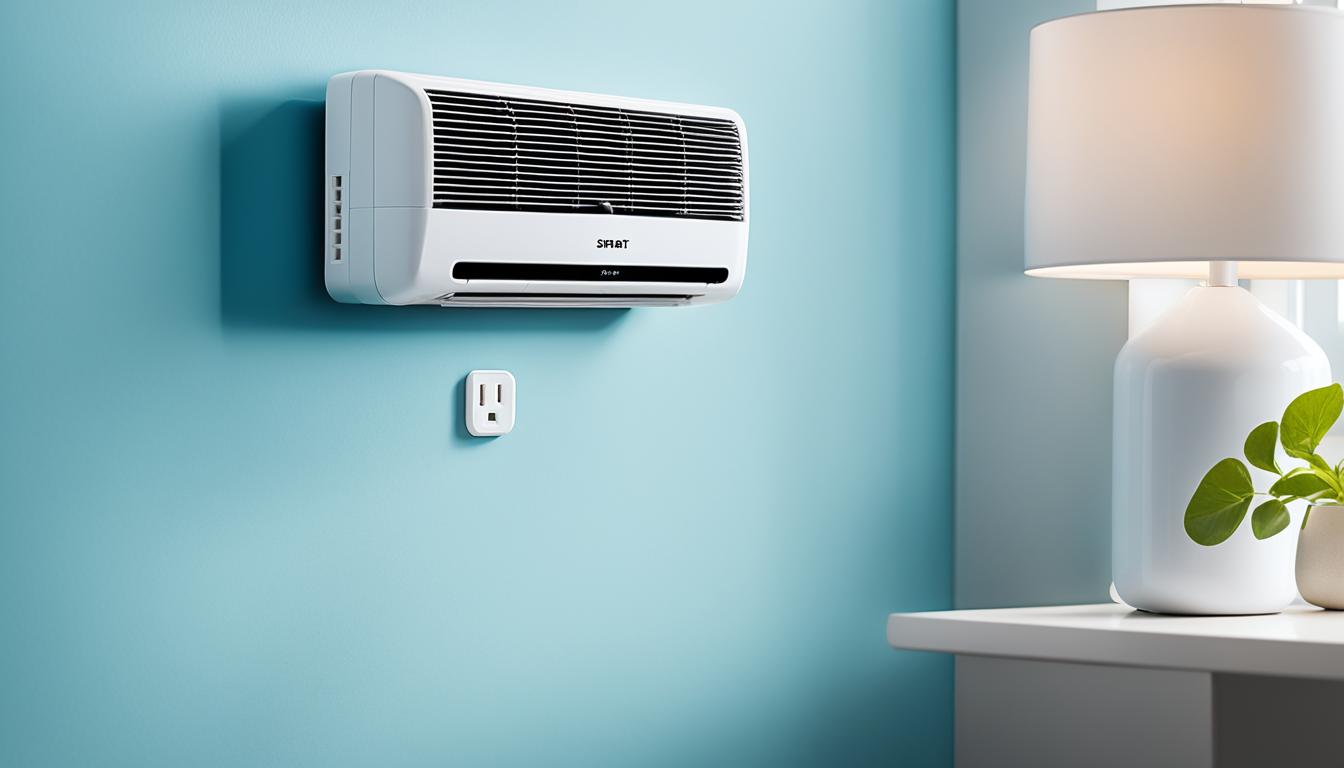
Did you know regular air conditioners can become intelligent with smart plugs? It’s pretty neat! By using smart plugs, you can control your air conditioner with your phone. This not only makes your home smarter but also helps save energy. Choosing the right smart plug can be a challenge, but don’t worry, we’re here to assist you! In this guide, we will showcase the best smart plugs for air conditioners. This will help you make a wise choice and upgrade your home’s intelligence level.
Key Takeaways:
- Smart plugs can turn ordinary air conditioners into smart devices that can be controlled from a smartphone.
- Choosing the right smart plug is important for convenience, control, and energy efficiency.
- The EVVR Smart Energy Monitor Plug and Relay is the top pick for a smart plug for air conditioners.
- The Kasa Smart Plug Mini and Kasa Smart Plug (2-Pack) offer great options at different price points.
- The Kasa Smart Plug Power Strip is the best choice for a smart power strip for air conditioners.
Why Use Smart Plugs for Air Conditioners?
Smart plugs make using air conditioners easy, efficient, and smart. They help your air conditioner work smarter. You can control it from your phone. This means you use less energy and save money. Here’s why smart plugs are a great choice for air conditioners:
Convenience at Your Fingertips
With a smart plug, you can easily control your air conditioner from anywhere. You can be at work or away and still turn it on or off. This means no more wasted energy when the house is empty.
Set Schedules for Better Efficiency
Smart plugs let you set times for your air conditioner to run. This matches your daily life, so you’re comfortable at home. When you’re not there, you save energy. This cuts your power bills and uses less energy.
Monitor Power Consumption
Using smart plugs means you can watch how much power your air conditioner uses. Many smart plugs show you this in their apps. Knowing this helps you use your air conditioner better. You save more energy this way.
Smart plugs do more than make life easier. They also help the planet. By using less energy, we save resources and reduce our carbon footprint.
When picking a smart plug, think about if it works with your air conditioner. Check how easy it is to use. Look for ones that monitor energy. Soon, we’ll talk about choosing the best smart plug for your air conditioner.
Factors to Consider When Choosing a Smart Plug for Air Conditioners
Choosing a smart plug for your air conditioner involves several factors. We aim to help you decide wisely. Let’s go over the main points to consider.
Compatibility
First, ensure the **smart plug** fits your **air conditioner**. **Smart plugs** vary, each made for different **air conditioner** types. Check that the **smart plug’s** voltage and amperage match your unit. Always check these details before buying to avoid any issues.
User-Friendly Mobile App
A good mobile app is also essential. Opt for a **smart plug** with a simple, easy app. It should let you control and schedule your **air conditioner** easily. The app should have a clean interface, custom settings, and let you change settings remotely.
Energy Monitoring Capabilities
Choosing a **smart plug** with energy tracking is smart. It lets you see how much energy your **air conditioner** uses. This information helps you use your **air conditioner** more efficiently. And that can lower your energy bills.
Pro Tip: Energy monitoring can guide when to turn your **air conditioner** on or off. This can save a lot of energy over time.
Customer Reviews and Ratings
Don’t forget to read customer reviews and ratings. Reviews from others who bought the **smart plug** can show its quality and performance. Search for feedback about how it works with **air conditioners** and its ease of use.
“I love how easy it is to control my **air conditioner** with this **smart plug**. The mobile app is simple to navigate, and the energy monitoring feature helps me keep track of my energy usage.” – Samantha
Price and Budget
Think about how much you want to spend on the **smart plug**. Although you should look for good value, a quality **smart plug** can save money and hassle in the long run. Compare prices to find the best **smart plug** for your budget.
Best Smart Plug for Air Conditioners – EVVR Smart Energy Monitor Plug and Relay
The EVVR Smart Energy Monitor Plug and Relay is the top pick for air conditioners. It has superior features, making it perfect for making your air conditioner smart.
This plug can handle the power of air conditioners with its high 16 Amp rating. This means you can use it with many air conditioner models. It’s great for using with the unit you already have.
The EVVR Plug works well with your smart home setup. It’s compatible with HomeKit. This lets you control your air conditioner with Siri or the Apple Home app. Controlling it from your phone or other Apple devices is easy.
This smart plug is very energy efficient. It uses 90% less energy than others. This is good for the planet and helps save on energy bills.
With the EVVR Plug, safety is not a worry. It has features to protect against heat and too much power. This makes it safe and reliable. You won’t have to stress about overheating or electrical issues.

To sum up, the EVVR Plug is the best choice for your air conditioner. It has a high amp rating and works with HomeKit. It’s energy efficient and safe. Upgrading your air conditioner with it makes your home smarter and more efficient.
Types of Air Conditioner Plugs
Air conditioner plugs vary by model and power needs. Knowing the different types is crucial. This knowledge prevents electrical problems. Here are some common types of air conditioner plugs:
1. Parallel Plugs (115 V/15 Amp)
Parallel plugs suit air conditioners needing 115 volts and up to 15 amps. They fit in standard home outlets. They’re good for smaller air conditioning units.
2. Perpendicular Plugs (208 to 230 V/20 Amp)
Perpendicular plugs are for high-voltage air conditioners, between 208 and 230 volts and up to 20 amps. They meet the needs of larger air conditioning units with their special design.
3. Tandem Plugs (230 V/15 Amp)
Tandem plugs power 230 volt air conditioners with a max of 15 amps. These plugs go into dedicated circuits. They are often seen in places with higher power needs.
4. Large Tandem Plugs (230 V/30 Amp)
Large tandem plugs are bigger versions of tandem plugs, with a 30 amp rating. They power big air conditioners needing 230 volts. You see them in large commercial or industrial setups.
Always check your air conditioner’s manual for the right plug. The wrong plug can be risky and harm your air conditioner. Safety is key with electrical work.

Does a Plug-in Air Conditioner Use a Lot of Electricity?
Plug-in air conditioners use a good amount of electricity. A central air unit might use 3,000 to 3,500 watts per hour. The age of your air conditioner, its energy efficiency, and even outdoor temperatures can impact how much electricity it uses. Choosing an energy-efficient model and using it smartly can help save electricity.

The amount of electricity plug-in air conditioners use can change. It depends on how efficient the unit is. Newer, energy-saving models use less electricity than older ones.
The condition of your air conditioner affects its electricity use, too. Doing regular maintenance can make it more energy-efficient. This includes cleaning or changing air filters. It’s also smart to check your insulation for any leaks.
High outdoor temperatures make your air conditioner work more. This increases electricity usage. Using blinds or curtains to keep the sun out can help. This makes your air conditioner work less and saves electricity.
To better understand how much electricity plug-in air conditioners use, let’s look at a comparison:
| Plug-in Air Conditioner | Electricity Usage (Watts Per Hour) |
|---|---|
| Model A | 2,500 |
| Model B | 3,000 |
| Model C | 3,500 |
Different models use different amounts of electricity. When choosing an air conditioner, think about its energy needs. Pick one that meets your energy-saving goals.
Choosing an energy-saving air conditioner is smart. You can use less electricity by setting it to an efficient temperature. Using smart plugs and programmable thermostats can help too. These steps save electricity and help the planet.
In short, plug-in air conditioners do use lots of electricity. But, you can lower this by picking an efficient model and using it wisely. With the right choices and habits, you can keep cool without using too much electricity.
Tips to Save Electricity When Using an Air Conditioner
Using an air conditioner smartly can save you money. There are ways to cut energy use and bills. Here are some key steps:
1. Proper Insulation and Sunlight Protection
Make sure your room is well sealed. Check for leaks around windows and doors. Use blinds or curtains to keep out sunlight. This keeps your room cooler.
2. Install a Programmable Thermostat
A programmable thermostat can save power. Set it to match when you’re home. This stops you from cooling an empty room.
3. Opt for an Energy-Saving Smart Plug
An energy-saving smart plug tracks your AC’s power use. It lets you set schedules. This cuts down on wasted energy.
4. Regular Cleaning and Maintenance
Clean air filters often to keep your AC efficient. Dirty filters block airflow. This makes the AC use more energy.
5. Choose a High SEER Rated Air Conditioner
The SEER rating tells you how efficient an AC is. Higher is better. Choosing one saves electricity over time.

| Tip | Description |
|---|---|
| Proper Insulation | Ensure the room is well-insulated and protected from heat transfer. |
| Programmable Thermostat | Install a programmable thermostat to set temperature schedules. |
| Energy-Saving Smart Plug | Use a smart plug to monitor and control the air conditioner’s power usage. |
| Regular Cleaning and Maintenance | Clean and maintain air filters for optimal airflow and energy efficiency. |
| Choose a High SEER Rated Air Conditioner | Opt for air conditioners with higher SEER ratings for better energy efficiency. |
These tips help you use less energy without giving up comfort. Using them can save you money and protect the planet.
Best Smart Plug for Air Conditioners – Kasa Smart Plug Mini with Energy Monitoring (4-Pack)
The Kasa Smart Plug Mini with Energy Monitoring (4-Pack) is our top pick. It’s perfect for air conditioners. With an easy app, energy tracking, and works with Amazon Alexa, Google Assistant, and Apple HomeKit.
This smart plug comes in a set of four. Great for controlling several air conditioners or devices at home. It’s small so it won’t block other outlets. No extra hub is needed, making setup simple.
The Kasa Smart Plug Mini’s energy-monitoring feature lets you see your air conditioner’s power use. This helps you save energy and reduce costs. It’s good for the planet too.
With the Kasa app, control your air conditioner from anywhere. Set it to turn on or off on schedule. Or set scenes with other smart devices. It offers both convenience and energy efficiency.
| Key Features | Benefits |
|---|---|
| Energy monitoring | Track and optimize air conditioner power consumption |
| User-friendly app | Easily control and manage your air conditioner |
| Compatibility with Amazon Alexa, Google Assistant, and Apple HomeKit | Integrate with your smart home ecosystem |
| Compact size | Does not obstruct adjacent outlets |
| No hub required | Simple setup process |
Upgrade your air conditioner with the Kasa Smart Plug Mini. Enjoy the convenience and energy savings in your home.

Best Value Smart Plug for Air Conditioners – Kasa Smart Plug (2-Pack)
The Kasa Smart Plug (2-Pack) is a top choice for those wanting affordable smart plugs. Its app is easy to use. It works with Amazon Alexa and Google Assistant too. This makes it perfect for any smart home.
“The Kasa Smart Plug (2-Pack) provides reliable performance and excellent value for upgrading your air conditioner.” – John, Smart Home Enthusiast
The Kasa Smart Plug (2-Pack) doesn’t have energy tracking or work with Apple HomeKit like the Kasa Smart Plug Mini. But it’s still a fantastic deal. With two plugs in one pack, you can control multiple devices without spending too much.
Features of the Kasa Smart Plug (2-Pack)
- Remote Control: Turn your air conditioner on or off from anywhere using the Kasa app.
- Voice Control: Control your air conditioner with simple voice commands through Amazon Alexa or Google Assistant.
- Scheduling: Set schedules to automatically turn your air conditioner on or off at specific times.
- Away Mode: Randomize your air conditioner’s schedule to create the illusion of an occupied home when you’re away.
This plug is reliable, easy to use, and budget-friendly. It’s a great way to make your air conditioner smarter. By getting a Kasa Smart Plug (2-Pack), you’re choosing convenience and energy savings. Don’t wait to upgrade your air conditioner with this smart plug.
| Pros | Cons |
|---|---|
|
|
Whether you love smart homes or are new to smart devices, the Kasa Smart Plug (2-Pack) is a great find. It makes upgrading your air conditioner easy and valuable. Start enjoying a cooler and smarter home today.

Best Smart Power Strip for Air Conditioners – Kasa Smart Plug Power Strip
The Kasa Smart Plug Power Strip is the best for air conditioners and more. It has many features that make it top-notch.
Control and Convenience
This power strip has six smart outlets and three USB ports. It lets you manage your air conditioner and other things. You can control each outlet on your own with just your smartphone.
It also works with Amazon Alexa and Google Assistant. So, you can use voice commands to control your air conditioner. This makes it easier to keep your home cool.
Surge Protection and Energy Monitoring
Another great thing about this power strip is its surge protection. This keeps your devices, like your air conditioner, safe from power surges. It’s a great way to protect your valuable items.
Plus, it lets you monitor your energy use. You can see how much energy your air conditioner uses. This helps you save on electricity bills by using energy wisely.

A Versatile Solution
This power strip fits perfectly into your smart home. It’s easy to use with its app. You can set schedules, create routines, and watch how much power you use.
The Kasa Smart Plug Power Strip is the top choice for making your air conditioner smart. It’s good for control, safety, and saving energy. It does a great job with air conditioners and other devices.
Conclusion
Smart plugs make using air conditioners smarter and save energy. It’s smart to pick the best plug for your needs. Look for ones that match your air conditioner and have good app control.
The EVVR Smart Energy Monitor Plug is our favorite. It’s safe, saves power, and can handle big jobs. The Kasa Smart Plug Mini and others from Kasa are also great choices. They can make your air conditioner smarter.
Adding a smart plug can make your home better. You can control your air conditioner easily, save on power, and make your home smarter. Smart plugs are a good step towards an energy-smart home.
FAQ
Why should I use smart plugs for my air conditioners?
What factors should I consider when choosing a smart plug for my air conditioner?
What is the best smart plug for air conditioners?
What types of plugs are available for air conditioners?
Do plug-in air conditioners consume a lot of electricity?
How can I save electricity when using an air conditioner?
What is the best smart plug for air conditioners in terms of energy monitoring?
What is the best value smart plug for air conditioners?
What is the best smart power strip for air conditioners?
How can smart plugs upgrade my air conditioner?
Source Links
- https://www.pcmag.com/picks/the-best-smart-plugs-and-power-strips
- https://www.popularmechanics.com/technology/g35729199/best-smart-plugs/
- https://evvr.io/blogs/newsroom-2/using-smart-plug-for-air-conditioner-to-make-it-energy-efficient
Claire is our in-house smart home guru. With a visionary background in electrical engineering and a professional history dotted with stints at leading tech companies, Claire has an unparalleled understanding of smart home technology. She has a talent for demystifying complex concepts, making them accessible to everyone, from tech novices to enthusiasts. Whether it’s the latest in home automation or the newest intelligent kitchen gadget, Claire’s insights help you confidently navigate the smart home landscape.
-

 Expert2 months ago
Expert2 months agoTop 15 Luxury Kitchen Appliance Brands Reviewed
-
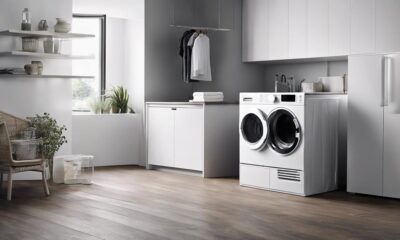
 Vetted2 months ago
Vetted2 months ago8 Best Condensing Tumble Dryers for Efficient Drying Performance
-

 Expert2 months ago
Expert2 months agoWhich Appliances Are Made in Canada
-

 Expert2 months ago
Expert2 months agoWhere Is Smeg Appliances Made
-

 Vetted2 months ago
Vetted2 months ago15 Best Brand Refrigerator Water Filters to Keep Your Water Clean and Fresh
-

 Vetted2 months ago
Vetted2 months ago15 Best Fruit and Vegetable Washing Machines for Cleaner, Safer Produce
-

 Expert2 months ago
Expert2 months agoHow Many Appliances Can a 1 Inch Gas Line Supply
-
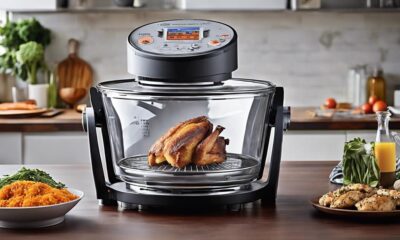
 Vetted2 months ago
Vetted2 months ago15 Best Halogen Ovens for Quick and Efficient Cooking








